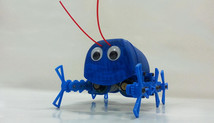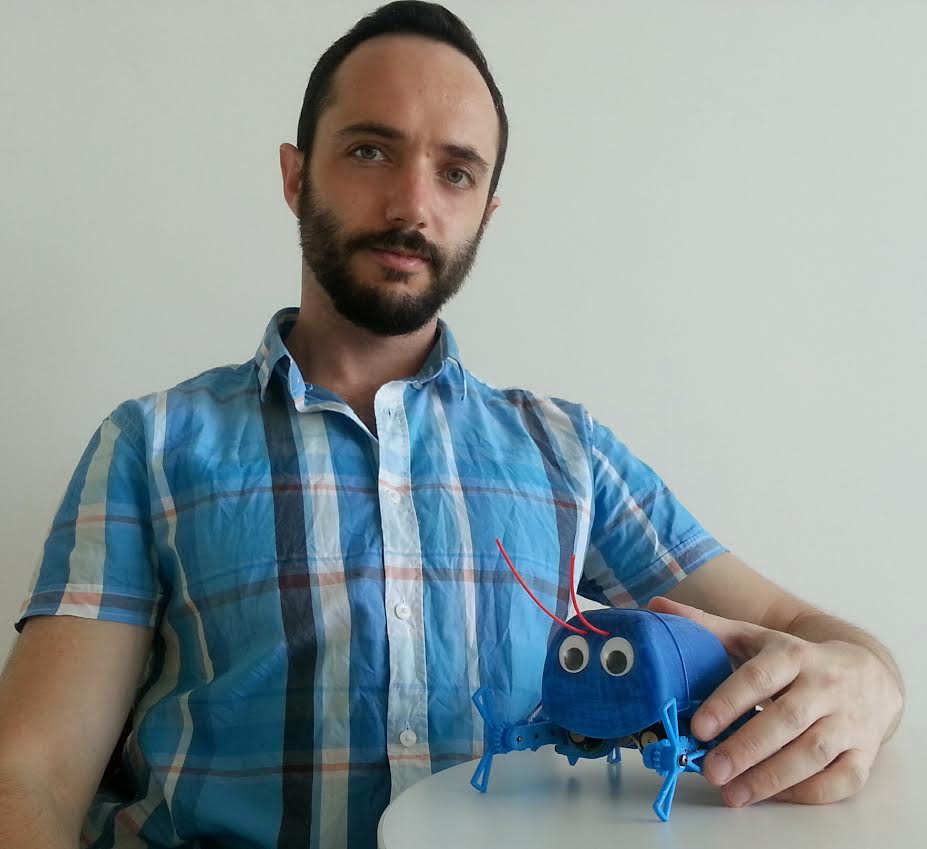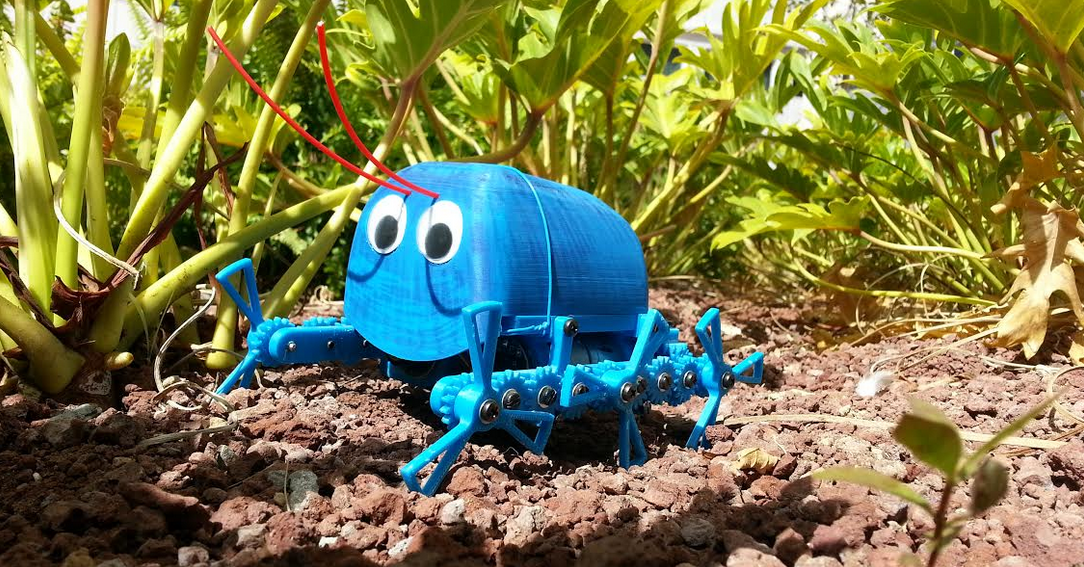/ News

Israeli Engineer 3D Prints Versatile Hexapod Robot named ‘Billy’
t’s really amazing how creative people are getting in combining the near infinite manufacturing capabilities that 3D printing has to offer with the DIY open-source physical computing platform, Arduino, which is based on a simple microcontroller board. Forgetting the fact that Arduino themselves will be entering the 3D printing space with their own printer shortly, the two technologies combined can provide an amazing toolset for some pretty amazing do-it-yourself electronics projects.

Jonathan Spitz
One such project, for a hexapod robot named ‘Billy’, is quite incredible if you were to ask me. Billy was developed by a PhD student named Jonathan Spitz at the Sensory-Motor Integration Laboratory (SMILE), headed by Assoc. Prof. Miriam Zacksenhouse. The lab is part of the Faculty of Mechanical Engineering at the Technion, Israel’s Institute of Technology.
“The main area of research at the Sensory-Motor Integration Laboratory (SMILE) is walking robots,” explained Spitz to 3DPrint.com. “During my PhD, I developed bio-inspired controllers for dynamic walking which work really well in simulation, but are hard to implement in your run-of-the-mill biped robot. Most state-of-the-art dynamic walking robots use either hydraulic actuators or series-elastic actuators. The latter are composed of DC motors in series with some elastic element that gives the joint some flexibility (which is needed to compensate for the rigidity of the motors’ gearboxes). In order to expedite the design process of prototypes that use these actuators we decided to purchase a 3D printer and start with small prototypes. Working on Billy was a good way to get some experience with mechanical design for 3D printing.”
So Spitz set out to 3D print his own walking hexapod, using an UP! Plus 2 3D printer from Easy3D, ABS filament, and an Arduino Leonardo board. Before creating the robot you see in the images and video, several prototypes were first created and tested. They all featured numerous 3D printed gears and leg types, as well as a variety of rather affordable electronic components. The second prototype of the robot used ABS printed axles, which from the video below, you can see did not hold up very well to the shear stress encountered. From there he decided to use M3 screws for the gear axles which significantly reduced the friction experienced on the gears. After the forth prototype, the hexapod was walking and was ready to be fitted with the body of Billy.
The entire process, from conceptualization of Billy to the final working prototype, took just 20 days. Spitz tells us that approximately half of this time was used programming the Arduino board and waiting around for components to arrive, while the other half included designing, printing and assembling the various prototypes. As for the time it took to print the final working prototype, Spitz provided us with an estimation:
“Because most of the parts were printed with a 0.15mm resolution they take quite a while to print. The slowest part is the cover, which takes 7 hours to print. Billy’s body, which holds the electronics and connects between both leg sets, takes 4 hours to print. Each set of 3 legs takes about 3 hours to print and then there’s some more gears and motor housings left. Ball-parking it, I’d say it takes 24 hours to print all the parts.”
As for the parts needed that were not 3D printed, here is the list:
- (1) Arduino Leonardo
- (1) BlueSMiRF bluetooth module
- (1) Motor Driver
- (2) DC motors + encoders
- (2) LiPo batteries (3.7V 2000mAh each)
The robot is easily controlled using a smartphone or tablet via Bluetooth, and Spitz has created two different sets of legs for Billy; the spiral ones as shown in the video and images, as well as a set that are straight. Spitz will next turn his attention to printing out a baby brother for Billy, one which is about 20% the size of Billy, which already measures just 4″ tall and 6″in length. As for his ultimate goal, it is to build a robot based on the current model and extend the model to further resemble human form. In his drive to first make a smaller hexapod, he will certainly have his work cut out for him.
“The problem with 3D printing a miniature walking robot is that our printer’s resolution is barely high enough to print the tiny gears that Billy uses,” Spitz explained to us. “Because all the gears printed were slightly different from each other, one of the challenges with Billy was finding the sweet-spot between dealing with too much friction between gears and a loose gear mesh. Heck, if it wasn’t challenging we wouldn’t be doing it!”
It will certainly be interesting to watch as this project develops, and see if a smaller 3D printed hexapod can be created. In the meantime, check out the video of Billy below, and let us know what you think in the 3D printed hexapod robot forum thread on 3DPB.com
Source: http://3dprint.com/16953/billy-3d-printed-robot-hexapod/
/ About us
Founded by Russian entrepreneur Dmitry Itskov in February 2011 with the participation of leading Russian specialists in the field of neural interfaces, robotics, artificial organs and systems.
The main goals of the 2045 Initiative: the creation and realization of a new strategy for the development of humanity which meets global civilization challenges; the creation of optimale conditions promoting the spiritual enlightenment of humanity; and the realization of a new futuristic reality based on 5 principles: high spirituality, high culture, high ethics, high science and high technologies.
The main science mega-project of the 2045 Initiative aims to create technologies enabling the transfer of a individual’s personality to a more advanced non-biological carrier, and extending life, including to the point of immortality. We devote particular attention to enabling the fullest possible dialogue between the world’s major spiritual traditions, science and society.
A large-scale transformation of humanity, comparable to some of the major spiritual and sci-tech revolutions in history, will require a new strategy. We believe this to be necessary to overcome existing crises, which threaten our planetary habitat and the continued existence of humanity as a species. With the 2045 Initiative, we hope to realize a new strategy for humanity's development, and in so doing, create a more productive, fulfilling, and satisfying future.
The "2045" team is working towards creating an international research center where leading scientists will be engaged in research and development in the fields of anthropomorphic robotics, living systems modeling and brain and consciousness modeling with the goal of transferring one’s individual consciousness to an artificial carrier and achieving cybernetic immortality.
An annual congress "The Global Future 2045" is organized by the Initiative to give platform for discussing mankind's evolutionary strategy based on technologies of cybernetic immortality as well as the possible impact of such technologies on global society, politics and economies of the future.
Future prospects of "2045" Initiative for society
2015-2020
The emergence and widespread use of affordable android "avatars" controlled by a "brain-computer" interface. Coupled with related technologies “avatars’ will give people a number of new features: ability to work in dangerous environments, perform rescue operations, travel in extreme situations etc.
Avatar components will be used in medicine for the rehabilitation of fully or partially disabled patients giving them prosthetic limbs or recover lost senses.
2020-2025
Creation of an autonomous life-support system for the human brain linked to a robot, ‘avatar’, will save people whose body is completely worn out or irreversibly damaged. Any patient with an intact brain will be able to return to a fully functioning bodily life. Such technologies will greatly enlarge the possibility of hybrid bio-electronic devices, thus creating a new IT revolution and will make all kinds of superimpositions of electronic and biological systems possible.
2030-2035
Creation of a computer model of the brain and human consciousness with the subsequent development of means to transfer individual consciousness onto an artificial carrier. This development will profoundly change the world, it will not only give everyone the possibility of cybernetic immortality but will also create a friendly artificial intelligence, expand human capabilities and provide opportunities for ordinary people to restore or modify their own brain multiple times. The final result at this stage can be a real revolution in the understanding of human nature that will completely change the human and technical prospects for humanity.
2045
This is the time when substance-independent minds will receive new bodies with capacities far exceeding those of ordinary humans. A new era for humanity will arrive! Changes will occur in all spheres of human activity – energy generation, transportation, politics, medicine, psychology, sciences, and so on.
Today it is hard to imagine a future when bodies consisting of nanorobots will become affordable and capable of taking any form. It is also hard to imagine body holograms featuring controlled matter. One thing is clear however: humanity, for the first time in its history, will make a fully managed evolutionary transition and eventually become a new species. Moreover, prerequisites for a large-scale expansion into outer space will be created as well.
Key elements of the project in the future
• International social movement
• social network immortal.me
• charitable foundation "Global Future 2045" (Foundation 2045)
• scientific research centre "Immortality"
• business incubator
• University of "Immortality"
• annual award for contribution to the realization of the project of "Immortality”.




 LinkedIn
LinkedIn
 LiveJournal
LiveJournal
 Google
Google
 Twitter
Twitter
 Facebook
Facebook
 Я.ру
Я.ру
 ВКонтакте
ВКонтакте
 Mail.ru
Mail.ru